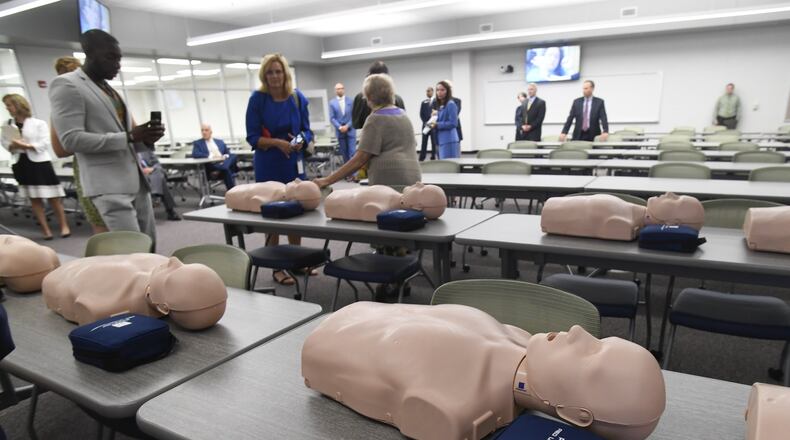The collapse and subsequent death of a teenage student earlier this month highlights the importance of emergency response training among school staff. Although an investigation is still ongoing, Clayton County officials have confirmed that Imani Bell, a junior at Elite Scholars Academy, suffered cardiac arrest during a preseason basketball workout.
Sudden cardiac death is the number one cause of exercise-related death in young athletes, according to researchers at Korey Stringer Institute at the University of Connecticut, which honors the legacy of the Minnesota Vikings offensive lineman who died of heat stroke during training camp in 2001. In the United States SCD is seen in all sports but mostly in basketball and football due to higher participation levels.
Bell, 16, collapsed on Aug. 13. Paramedics were called and found her unresponsive. Her pulse stopped and she stopped breathing in the ambulance. Firefighters administered CPR and she regained a pulse on the way to the hospital, but did not survive.
Clayton County Public Schools officials said all schools have two automatic external defibrillators, AEDs — one in the main office and the other in the gymnasium. These devices are accessible to everyone. All school nurses and other designees (teachers, school bus drivers, and nutrition staff) are trained in CPR with recertification every two years.
“In addition, it is mandated that all head coaches (middle and high school) are CPR certified,” said spokesman Ronald Shields. “The district is currently in the process of certifying all high school assistant coaches as well.”
It is unclear if anyone administered CPR or used an AED on Bell.
Georgia has required since 2010 that all schools have an automatic external defibrillator (AED) on site, and a bill passed in July requires that every student athlete and parents receive information about the early warning signs of sudden cardiac arrest.
Schools are also required to hold informational meetings twice a year regarding the symptoms and warning signs of sudden cardiac arrest.
Related story: Imani Bell loved basketball, was to graduate in 2021
Related story: School nurse uses 'Stop the Bleed' to save student
Related story: Gwinnett school police officer wins award for saving teacher, students
Fulton County has 270 AEDs with at least one in every school and administrative buildings. Middle schools have at least two and high schools have at least four to account for athletics.
“The Georgia High School Association and Fulton County Schools requires that every coach receive CPR and AED training prior to the start of each school year. Each of our high schools conduct this training during pre-planning,” said spokeswoman Shumuriel Ratliff. “We use our athletic trainers, employees that are CPR/AED instructors, and our hospital partnerships to conduct these trainings.”
According to the Centers for Disease Control and Prevention, 70% to 90% of people who experience sudden cardiac arrest outside a hospital will die, mainly because aid isn’t administered quickly.
During a cardiac arrest, the electrical activity in the heart is disrupted. Without immediate CPR, the heart, brain and other vital organs aren’t receiving enough oxygenated blood. For every minute without CPR, the chance of death increases by 10%, according to the American Heart Association. The survival rate outside of a hospital setting is only 1% to 5%, but the chance of survival increases considerably if the person can be immediately treated with an AED.
Even the fastest paramedics could take eight to 12 minutes to get to a patient who has collapsed. Quick access to an AED could increase the odds of survival from about 5% to 40% and higher according to the National Safety Council, a nonprofit organization with the mission of eliminating preventable deaths.
“There’s been a lot of activity with the state legislature on this subject,” said Jennifer Poole Ross, lead nurse with Gwinnett County schools. “It’s important for athletes and parents to understand what could happen and how to react in the event of a cardiac arrest.”
She added that the technology for AEDs has advanced so much in recent years that anyone can administer aid.
“Studies have shown that people were hesitant to push the button to activate the electronic pulse,” she said. “So the next generation is completely automatic. All you have to do is place the pads on the person and the machine determines the level of shock they need and if they need it at all.”
Sixty-six percent of victims who received a shock from AED from a bystander survived, American Heart Association data shows. The research stressed that receiving cardiac care before responders arrived often saved the victim from a tragedy.
“Keeping calm and reacting quickly saves lives,” said Ross. “Our staff has shown on many occasions that the training works. It prepares them so they know what to do.”
What is sudden cardiac arrest?
Cardiac arrest is not the same as a heart attack. With cardiac arrest, the heart suddenly stops beating. During a heart attack, blood flow is blocked to some part of the heart, damaging that area of the organ but not stopping it altogether.
Sudden Cardiac Arrest is a life-threatening emergency that occurs when the heart suddenly stops beating. It strikes people of all ages who may seem to be healthy, even children and teens. When SCA happens, the person collapses and doesn’t respond or breathe normally. They may gasp or shake as if having a seizure. SCA leads to death in minutes if the person does not get help right away. Survival depends on people nearby calling 911, starting CPR, and using an AED (if available) as soon as possible.
An AED automatically assesses the heart’s rhythm and decides if it should be shocked or not. If a shock is going to be delivered, the machine warns the operator to stand clear and then gives the shock. The device reassesses the heart rhythm, and if necessary, delivers further shocks.
Source: American Heart Association
About the Author
Keep Reading
The Latest
Featured


